|
Order:
Malpighiales
Life
> eukaryotes >
Archaeoplastida >
Chloroplastida
>
Charophyta > Streptophytina > Plantae (land plants)
> Tracheophyta (vascular plants) > Euphyllophyta > Lignophyta (woody plants)
> Spermatophyta (seed plants) > Angiospermae (flowering
plants)
> Eudicotyledons > Core Eudicots > Rosids > Eurosid
I
About 39 families, 716 genera and 15935 species of which 19
families, 160 genera and 974 species are encountered in southern Africa. Of
these, 120 genera and 800 species are native, an additional eight genera and 47
species are naturalised, and an additional 32 genera and 128 species are
cultivated in the region.
Families encountered in southern Africa
|
Achariaceae
Thirty genera and 145 species (pantropical), with six
genera and seven species native to southern Africa.
|
 |
|
Chrysobalanaceae
Seventeen genera and about 460 species worldwide
(lowland tropics and subtropics), with three genera and four species native to
southern Africa. In addition, there are four genera and four species that are cultivated
in the region. |
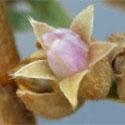 |
|
Clusiaceae
Twenty-seven genera and about 1050 species (tropical) with
one genus (Garcinia) and four species native to southern Africa. An
additional genus and four species are cultivated in the region.
|
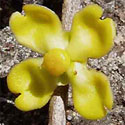 |
|
Dichapetalaceae
There are three genera and about 165 species (tropics and
subtropics), with two genera and seven species native to southern Africa.
|
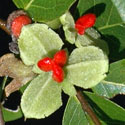 |
|
Elatinaceae
Two genera and thirty-five species (worldwide, mainly
tropical). Both genera and 12 species are native to southern Africa. |
|
|
Erythroxylaceae (Coca family)
There are four species and about 260 species worldwide
(tropics, mainly America), of which two genera and six species are native to
southern Africa. The Coca tree, Erythroxylum coca (which has been
cultivated in southern Africa) yields the alkaloid
cocaine, a narcotic drug used in medicine and illegal drug use. |
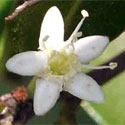 |
|
Euphorbiaceae (Poinsettia and Cassava family)
There are 218 genera and about 5735 species in the
Euphorbiaceae worldwide, of which 49 genera and 527 species are native to southern
Africa, six genera and 25 species are naturalised, and a further 14 genera and
43 species are cultivated in the region.
|
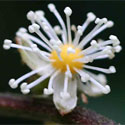 |
|
Hypericaceae
Of the nine genera and 560 species distributed worldwide,
three genera
occur in southern Africa, where there are ten native, three naturalised
and an additional 14 cultivated species. All three genera were previously
placed in the
Clusiaceae. |
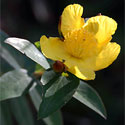 |
|
Linaceae (Flax family)
There are 12 genera and about 300 species worldwide
(cosmopolitan) of which two genera and 15 species are native to southern Africa,
and a further one genus and six species are cultivated in the region.
|
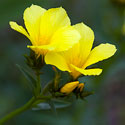 |
|
Malpighiaceae
Sixty-eight genera and 1250 species worldwide (tropics and subtropics,
mainly America), with four genera and 10 species
native to southern Africa. An additional six genera and seven species are
cultivated in the region.
|
 |
|
Ochnaceae
Twenty-seven genera and 495 species (mainly pantropical), with
three genera and 30 species native to southern Africa.
|
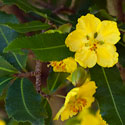 |
|
Passifloraceae (Granadilla family)
Twenty-seven genera and about 935 species worldwide, of
which eight genera and 39 species are native to southern Africa, and one genus (Passiflora)
and eight species are naturalised in the region. An additional six species are cultivated in the region.
Turneraceae was previously considered to be a separate family, but it has now
been merged into Passifloraceae. |
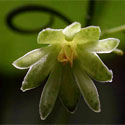 |
|
Podostemaceae
Of the 48 genera and 270 species (mainly tropical), four
genera and five species are native to southern Africa. |
|
|
Phyllanthaceae
Fifty-nine genera and 1745 species (pantropical, especially
Malesia), with 11 genera and 68 species native to southern Africa, one
naturalised species and an
additional two genera and three species that are cultivated in the region. Members of
this family were previously placed in the
Euphorbiaceae. |
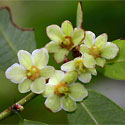 |
|
Picrodendraceae
Twenty-four genera and about 80 species (tropical mainly),
with two genera, each with a single species, native to southern Africa. |
|
|
Putranjivaceae
Three genera and about 210 species (tropical, mainly
Africa and Malesia), with one genus (Drypetes)
and five species native to southern Africa. In addition, Putranjiva
roxburghii (Tsuge-modoki), native from India to Burma, is cultivated in
southern Africa. |
|
|
Rhizophoraceae (mangrove family)
About 16 genera and 149 species worldwide (tropics and
subtropics of Africa, Asia and America), of which four genera and 10 species
are native to southern Africa. One of the genera, Cassipourea, does not
occur in mangrove forests but occurs in other types of forests and woodland. |
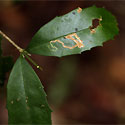 |
|
Salicaceae (willow and poplar family)
Fifty-five genera and about 1010 species (worldwide), with 10 genera and 26
species native to southern Africa, a further one genus and seven species
that are naturalised, and a further three genera and 28 species that are
cultivated in the region. The family used to incude two genera (Salix
and Populus - the willows and poplars) but based on genetic evidence
mainly, the family now includes the majority of the genera that used to be
placed in the Flacourtiaceae. |
 |
|
Violaceae (Pansy and Violet family)
Twenty-three genera and about 800 species worldwide (mainly
tropical but the large Viola genus occurs predominantly in temperate
regions), of which three genera and 13 species are native to southern Africa,
three species are naturalised, and an additional genus and nine species are
cultivated in the region. |
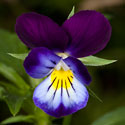 |
Families not encountered in southern Africa
Balanopaceae, Bonnetiaceae, Caryocaraceae,
Centroplacaceae, Ctenolophonaceae, Euphroniaceae, Goupiaceae, Humiriaceae,
Irvingiaceae, Ixonanthaceae, Lacistemataceae, Lophopyxidaceae, Malesherbiaceae,
Medusagynaceae, Pandaceae, Quiinaceae, Rafflesiaceae,
Trigoniaceae
|
